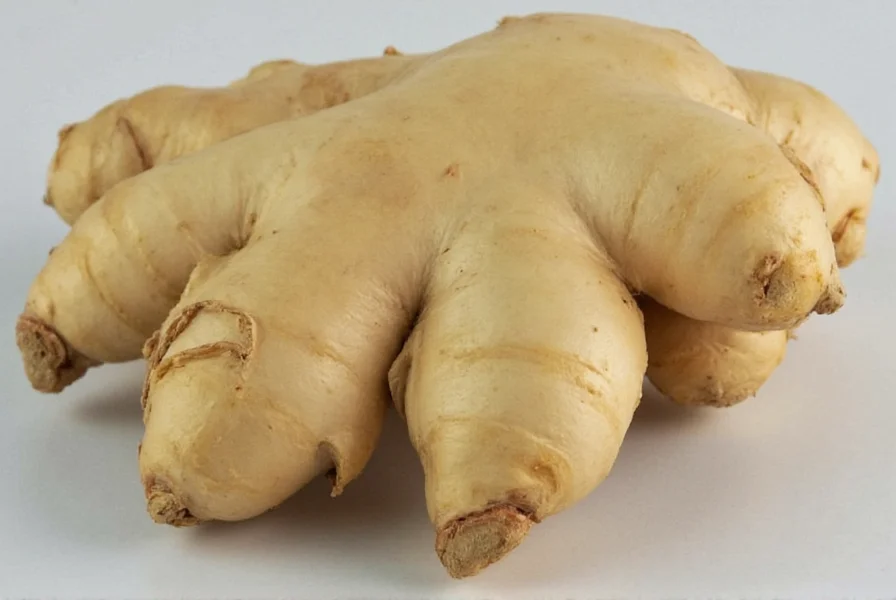Mother ginger represents the mature stage of the ginger rhizome's growth cycle. Unlike baby ginger, which is harvested early when the skin is still thin and tender, mother ginger reaches full maturity, developing a tougher, woody exterior and a more intense, complex flavor profile. This mature form constitutes the majority of ginger available in supermarkets worldwide and serves as the foundation for countless culinary and medicinal applications.
Understanding Ginger's Growth Cycle
Ginger plants develop through distinct growth phases that directly impact the characteristics of the harvested rhizomes. The growth cycle begins with planting a ginger "seed" rhizome, which sprouts shoots and develops root systems. As the plant matures over 8-10 months, the original rhizome transforms into what we call mother ginger.
During this maturation process, several key changes occur:
| Growth Stage | Harvest Time | Physical Characteristics | Flavor Profile |
|---|---|---|---|
| Baby Ginger | 4-6 months | Thin, pale skin; tender texture | Mild, slightly sweet, less pungent |
| Mother Ginger | 8-10 months | Thick, fibrous skin; woody texture | Strong, spicy, complex flavor |
Mother Ginger vs. Baby Ginger: Key Differences
Understanding the distinction between mother ginger and baby ginger proves essential for culinary success. While both come from the same plant species, their harvesting time creates significant differences in texture, flavor, and culinary applications.
Mother ginger's extended growth period results in higher concentrations of gingerols (6-gingerol, 8-gingerol, and 10-gingerol), the bioactive compounds responsible for ginger's characteristic heat and many of its studied health properties. This mature ginger typically contains 1.5-2 times more gingerols than its younger counterpart, making it particularly valuable for applications requiring potent ginger flavor and potential health benefits.
Chefs and home cooks select mother ginger when they need:
- Stronger flavor that holds up during long cooking processes
- Higher potency for medicinal preparations
- Traditional recipes calling for mature ginger
- Situations where ginger's fibrous nature won't negatively impact texture
Culinary Applications of Mature Ginger
Mother ginger's robust flavor profile makes it indispensable in numerous global cuisines. Its ability to withstand extended cooking times without losing potency sets it apart from more delicate baby ginger.
In Asian cooking traditions, mother ginger serves as the foundation for:
- Curry pastes and spice blends that require prolonged simmering
- Stir-fry sauces where intense ginger flavor is essential
- Traditional medicinal preparations like ginger tea for colds
- Fermented ginger products that benefit from mature ginger's complex flavor
Western culinary applications include:
- Baking gingerbread and spice cakes where strong ginger flavor is desired
- Preserving as crystallized ginger
- Creating ginger-infused syrups for cocktails and beverages
- Adding depth to savory dishes like roasted meats and root vegetable preparations

Proper Preparation and Storage Techniques
Working with mother ginger requires specific preparation methods to maximize its culinary potential. The tough, fibrous nature of mature ginger demands different handling than its younger counterpart.
For optimal results when using mother ginger:
- Peel thoroughly using a spoon to remove the thick skin without wasting edible flesh
- Grate finely for even distribution in sauces and marinades
- Simmer longer in liquids to fully extract flavor compounds
- Consider using a ginger press for maximum juice extraction
Proper storage extends mother ginger's shelf life significantly. Store unpeeled rhizomes in a paper bag in the refrigerator's vegetable drawer for 2-3 weeks. For longer preservation, freeze whole or grated ginger in airtight containers for up to six months. The freezing process actually breaks down some fibers, making frozen-thawed mother ginger easier to work with while maintaining flavor intensity.
Nutritional Profile and Health Considerations
Mother ginger's extended growth period concentrates beneficial compounds while reducing water content. This mature form contains higher concentrations of gingerols, shogaols, and other bioactive compounds compared to younger ginger varieties.
Research indicates that the specific composition of compounds in mother ginger may offer several potential benefits:
- Supporting digestive health through enhanced gastric motility
- Potential anti-inflammatory effects from concentrated gingerols
- Antioxidant properties that increase as ginger matures
- Traditional use in managing nausea and motion sickness
When incorporating mother ginger into your diet for potential health benefits, remember that cooking methods affect compound availability. Gentle heating converts gingerols to shogaols, which some studies suggest have enhanced bioavailability. However, excessive heat can degrade beneficial compounds, so moderate cooking temperatures yield optimal results.
Common Misconceptions About Mother Ginger
Several misconceptions surround mother ginger that can lead to improper usage or unrealistic expectations. Understanding these clarifications helps maximize the ingredient's potential.
One prevalent myth suggests that older ginger is always better. In reality, the optimal ginger type depends entirely on the intended application. Mother ginger's intense flavor would overwhelm delicate dishes better suited to baby ginger. Another misconception claims that the fibrous nature of mature ginger indicates poor quality, when in fact this texture simply reflects the rhizome's maturity and concentrated flavor compounds.
Many people also confuse "mother ginger" with "ginger mother," which refers to the starter culture used in traditional ginger beer fermentation. These are entirely different concepts despite the similar terminology.
Practical Tips for Using Mother Ginger
Maximize your culinary experience with mother ginger by implementing these practical techniques:
- When substituting mother ginger for baby ginger in recipes, use approximately 25-30% less due to its stronger flavor
- Create ginger-infused oils by gently heating grated mother ginger in neutral oil, then straining
- For medicinal teas, slice rather than grate mother ginger to control potency
- Combine with acidic ingredients like citrus to balance its intense heat
- Store peeled ginger in sherry or vodka in the refrigerator for extended shelf life
Professional chefs often maintain both mother and baby ginger in their kitchens, selecting each based on the specific requirements of the dish. Understanding when to reach for the mature rhizome versus its younger counterpart elevates your cooking and ensures optimal flavor balance in every preparation.
Frequently Asked Questions
What exactly is mother ginger and how is it different from regular ginger?
Mother ginger refers specifically to the mature rhizome of the ginger plant that has reached full development (8-10 months). It differs from younger 'baby ginger' by having thicker, tougher skin, a more fibrous texture, and a stronger, more complex flavor profile with higher concentrations of gingerols. Most ginger sold in supermarkets is mother ginger.
Can I substitute mother ginger for baby ginger in recipes?
Yes, but with adjustments. Mother ginger has a stronger, more intense flavor than baby ginger, so you'll typically need to use about 25-30% less when substituting. For delicate dishes that specify baby ginger, mother ginger might overpower other flavors. In recipes requiring long cooking times, mother ginger often works better as its flavor holds up better during extended heat exposure.
Why does mother ginger have a tougher texture than young ginger?
The tougher texture of mother ginger results from its extended growth period (8-10 months versus 4-6 months for baby ginger). During this maturation process, the rhizome develops more fibrous tissue and a thicker, woody skin as it stores more starches and bioactive compounds. This natural development increases its gingerol content but also creates the characteristic fibrous texture that requires proper preparation techniques.
How should I properly store mother ginger to maximize freshness?
Store unpeeled mother ginger in a paper bag in your refrigerator's vegetable drawer for 2-3 weeks. For longer storage, freeze whole or grated ginger in airtight containers for up to six months. Freezing actually breaks down some fibers, making it easier to work with after thawing. Avoid storing ginger in plastic bags, which trap moisture and accelerate spoilage. Peeled ginger can be stored submerged in sherry or vodka in the refrigerator for extended shelf life.
Is mother ginger more nutritious than baby ginger?
Mother ginger contains higher concentrations of certain bioactive compounds like gingerols due to its longer growth period, but has slightly less water content. While it offers more potent flavor and potentially higher concentrations of certain compounds, baby ginger provides more vitamin C and a milder profile. Neither is inherently 'more nutritious'—they offer different nutritional profiles suited to different culinary and potential health applications.











 浙公网安备
33010002000092号
浙公网安备
33010002000092号 浙B2-20120091-4
浙B2-20120091-4